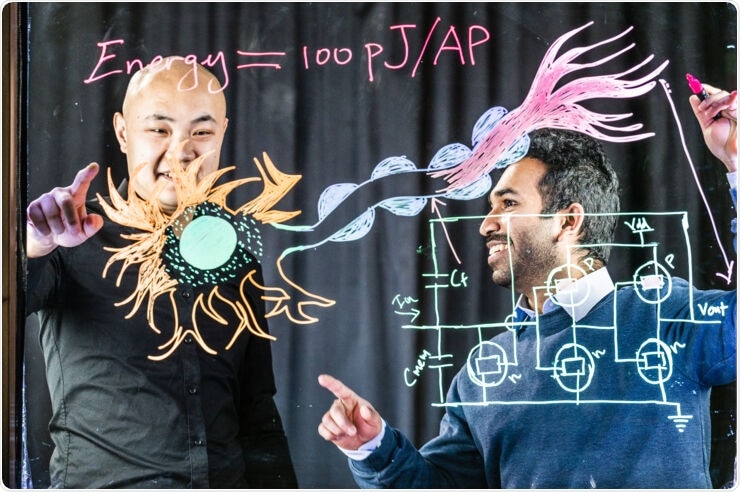Researchers, for the first time, establish an artificial organic neuron, or a nerve cell, which can be combined with an artificial organic synapse and a living plant. Both the synapse and the neuron are built of printed organic electrochemical transistors.

Chi-Yuan Yang and Padinhare Cholakkal Harikesh, post-doctoral researchers at the Laboratory of Organic Electronics, show in a schematic image how the human nerve cells and their functionality has been built using organic electrochemical transistors. Image Credit: Thor Balkhed.
The electrical pulses received from the artificial nerve cell can lead to the closing of plant leaves on connecting to the carnivorous Venus flytrap, even when no fly has entered the trap.
Both electrons and ions can be conducted by organic semiconductors, thus aiding to imitate the ion-based pulse mechanism (action potential) generation in plants. Here, the tiny electric pulse of below 0.6 V can instigate action potentials in the plant, in turn causing the leaves to close.
We chose the Venus flytrap so we could clearly show how we can steer the biological system with the artificial organic system and get them to communicate in the same language.”
Simone Fabiano, Associate Professor and Principal Investigator, Organic Nanoelectronics, Laboratory of Organic Electronics, Linköping University
Complementary circuits
In 2018, the research team at Linköping University became the first to design complementary and printable organic electrochemical circuits, that is, with both n-type and p-type polymers, conducting negative and positive charges and making it possible to construct printed complementary organic electrochemical transistors.
Consequently, the group has optimized the organic transistors, accordingly that they can be produced in printing presses on thin plastic foil. On a single plastic substrate, thousands of transistors can be printed.
Along with researchers in Lund and Gothenburg, the team has employed printed transistors to imitate the synapses and neurons of the biological system. The findings have been published in the esteemed journal Nature Communications.
“For the first time, we’re using the transistor’s ability to switch based on ion concentration to modulate the spiking frequency”, states Padinhare Cholakkal Harikesh, a post-doctoral researcher at the Laboratory of Organic Electronics.
The spiking frequency offers the signal that makes the biological system react.
Learning behavior
We’ve also shown that the connection between the neuron and the synapse has a learning behavior, called Hebbian learning. Information is stored in the synapse, which makes the signaling more and more effective.”
Simone Fabiano, Associate Professor and Principal Investigator, Organic Nanoelectronics, Laboratory of Organic Electronics, Linköping University
The anticipation is that artificial nerve cells could be utilized for delicate human prostheses, soft intelligent robotics, and implantable systems for relieving neurological diseases.
We’ve developed ion-based neurons, similar to our own, that can be connected to biological systems. Organic semiconductors have numerous advantages—they’re biocompatible, biodegradable, soft, and formable. They only require low voltage to operate, which is completely harmless to both plants and vertebrates.”
Chi-Yuan Yang, Post-Doctoral Researcher, Laboratory of Organic Electronics, Linköping University
Source:
Journal reference:
Harikesh, P. C., et al. (2022) Organic electrochemical neurons and synapses with ion mediated spiking. Nature Communications. doi.org/10.1038/s41467-022-28483-6.